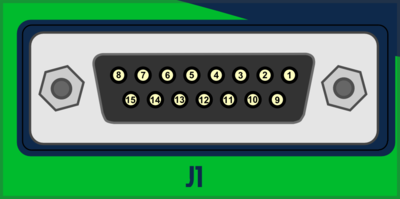Argon user guide/Wiring
This article state is work in progress & unchecked! Use at your own risk.
Contents
Front side connectors
J3 24V power and motor brake port
J3 is a 3 pole terminal block type connector used for supplying 24VDC to drive and optionally controlling motor solenoid brake.
| Pin | Description | Connection |
|---|---|---|
| BK | Motor brake output | If motor has a 24V solenoid brake, connect brake between BK and V+ |
| V+ | 24V supply positive input | Connect to 24V PSU + |
| V- | 24V supply ground | Connect to 24V PSU - |
24VDC typical current consumption is between 0.1 - 0.7ADC depending on how much current is drawn by feedback device and an optional motor brake.
J1 feedback device port
J1 connector type is 15 pin female D-Sub and should be mated with 15 pin male D-Sub counterpart.
J1 pinout is to be announced later.
J2.1 and J2.2 Simplemotion & E-stop ports
J2.1 and J2.2 are RJ45 type connectors and mates with standard Cat 5 & 6 ethernet cables. Both of these ports are connected pin-to-pin parallel to allow chaining of Argon devices. For J2.x pinout, see SimpleMotion V2 port article.
Normally an ethernet type cable is plugged from J2.1 or J2.2 to SimpleMotion V2 USB adapter
J4 power & motor port
J4 is a 10 pole terminal block connector for several functions: earthing, AC power input, motor output, regenerative resistor output and HV DC link sharing.
| dangerous & non-isolated mains potential voltages are present in this connector! Keep away from this connector when drive has been connected to AC mains during last 5 minutes. After unplugging AC power, 5 minutes is required for dangerous voltages to disappear from this connector. For more info, see Power supply safe discharging |
| Pin name | Descrpition | AC/BLDC motor connection | Brush DC motor connection |
|---|---|---|---|
| VN | HV DC link negative rail | Do not connect | |
| BR | Braking resistor output | Optional braking resistor first terminal. See Argon braking resistor | |
| VP | HV DC link positive rail | Optional braking resistor first terminal. See Argon braking resistor | |
| PE ⏚ | Protective earth | Connect to motor PE conductor and motor cable shield | |
| U | Motor phase output | Motor U phase lead | Motor armature+ |
| V | Motor phase output | Motor V phase lead | Motor amature- |
| W | Motor phase output | Motor W phase lead | No connection |
| L | AC mains supply Line | Connect to AC supply line | |
| N | AC mains supply Neutral | Connect to AC supply neutral | |
| PE ⏚ | Protective earth | Connect to earth. This connection is always mandatory when operating the device! | |
Side connectors
J5 Inputs/Outputs
J5 Is a 26 pin IDC connector located on the side of Argon. The connector serves as general purpose I/O including:
- Isolated digital inputs (4 pcs) - used for limit & home switches and clear faults signal
- Isolated digital outputs (4 pcs) - used for status indication
- Differential analog inputs (2 pcs) - used as Analog reference
- Differential digital inputs (2 pcs) - used for pulse/direction or second encoder
- 5V and GND output - used for supplying switches or external electronics
Mating connector type is 0.1" pitch 26 pin IDC ribbon cable socket, see example (pdf).
Mating parts
See list of Argon mating connectors and accessories
In no event the Product Information or parts hereof shall be regarded as guarantee of conditions or characteristics. The Product Information or any part thereof may also not be regarded as a warranty of any kind. No liability of any kind shall be assumed by Author with respect to Product Information or any use made by you thereof, nor shall Author indemnify you against or be liable for any third party claims with respect to such information or any use thereof.
As content of this Wiki may be edited by user community, Granite Devices Oy or it's affiliates do not take any responsibility of the contents of this Wiki. Use information at your own risk. However, Granite Devices staff attempts to review all changes made to this Wiki and keep information trustworthy.
Without written consent, Granite Devices' Products or Intellectual Property shall not be used in situations or installations where living beings, material property, or immaterial property could be harmed by the operation, features or failures of Product. Products may only be used in a way where hazards like moving parts, electric shock, laser radiation, or fire can't be realized even if the content of this Wiki would suggest otherwise.

